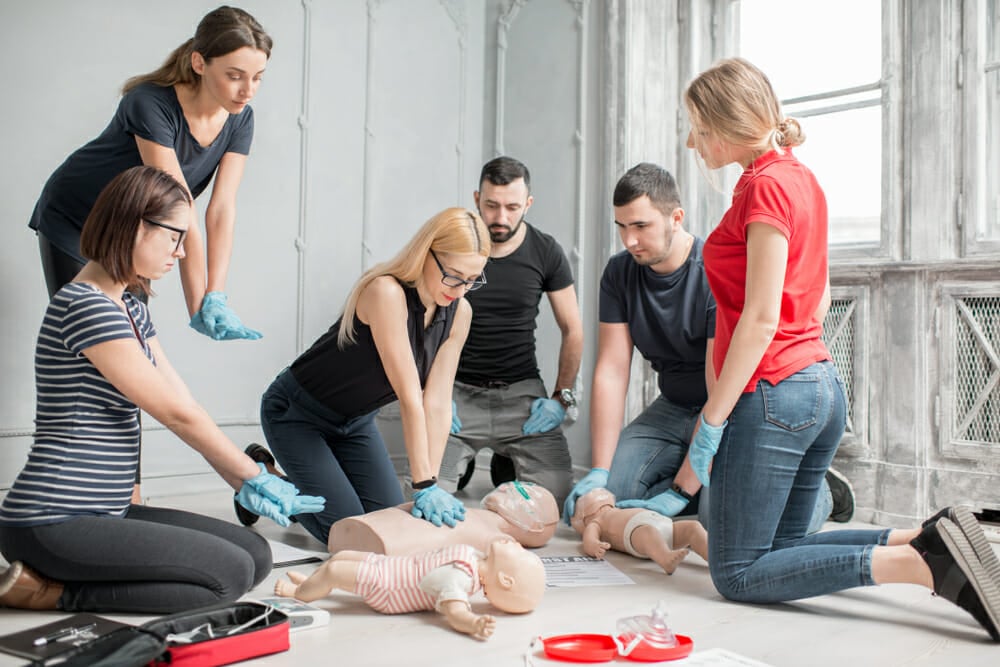
Last Updated On: enero 7, 2025
It can be incredibly stressful when a friend, coworker, or even a family member goes through an emergency medical situation such as a heart attack or cardiac arrest during CPR Compression depth. This medical condition causes problems in the patient’s cardiovascular system and halts the process of pumping blood to the core parts of the body.
The longer a person is in sudden cardiac arrest, the more their brain is deprived of the required amount of oxygen. This is what makes CPR a crucial life-saving skill that also entails the procedure of following the correct compression depth to administer it effectively. Let us explore more about this aspect in the blog..
A safe measure for the accurate chest compression depth in inches is about 2 – 2.4 inches for adults. It means there should be 30 chest compressions followed by 2 rescue breaths to open the airway for the patient accurately and on time. Pushing harder or greater than 2.4 inches could cause severe harm to the patient. That means if you conduct very shallow compressions, these may not be sufficient to pump blood and regulate blood flow in the victim’s body. So, keep up with the right rate and depth for chest compressions to be effective in making the patient’s chest rise as normally as possible.
Those well acquainted with the process of compression-only CPR and emergency cardiovascular care know that the first responder should position the heel of the hand at the center of the victim’s chest. Keep hands top on each other and fingers interlaced, keeping the arms long and pressing straight. Now, the responder pushes hard and fast to perform chest compressions similar to 2.4 inches or between 2-2.4 inches. It brings us to the next important point of high quality hands-on CPR technique. This process helps restore the oxygen-rich blood flow in the body, including the heart and the brain. Doing this procedure on time on an adult patient can protect them from brain death or damage.
Let us understand how the process of CPR is performed on the human heart.
Here is the ideal depth for chest compressions. Let’s break it down to understand better.
| Criteria | Depth (in inches) |
| Safe Measure | 2 2.4 |
| Recommended Compressions | 30 |
| Rescue Breaths | 2 |
Therefore, a proper depth ensures sufficient blood circulation and normal chest rise.
Ensuring the correct depth in chest compressions is crucial to avoid injuries like broken ribs. Here are ten ways to guarantee you’re pushing to the right depth each time:
Regular practice helps develop muscle memory for the correct depth.
Access online courses or local CPR classes for proper demonstrations.
Practice at facilities that provide CPR training and equipment.
Participate in local courses to receive hands-on guidance and feedback.
Switch rescuers every two minutes to prevent fatigue and maintain effective compressions.
Employ devices that provide real-time feedback on compression depth.
Adhere to established CPR guidelines for depth recommendations.
Regularly assess compression depth during training sessions.
Consult healthcare professionals or CPR instructors for advice on achieving the correct depth.
Continuously review CPR training materials to reinforce proper techniques and depth requirements.
Understanding the risks of improper chest compression depth is crucial for effective CPR. Here are eight potential risks to be aware of:
Ensuring proper hand placement during CPR is vital for effective chest compressions. Here are eight ways to guarantee correct hand placement:
Position the heel of your hand at the center of the victim’s chest.
Keep your hands stacked on top of each other.
Interlace your fingers to provide stability and maximize force distribution.
Maintain straight arms to apply consistent pressure during compressions.
Ensure that your hand placement avoids the xiphoid process to prevent injury.
Apply equal pressure with both hands to ensure balanced compressions.
Check that your hands are aligned with the victim’s sternum for optimal placement.
Continuously assess hand placement throughout CPR to maintain accuracy and effectiveness.
Are there any special considerations for performing CPR on specific populations, such as infants or pregnant women?
Performing CPR compressions on different populations requires special considerations to ensure effectiveness and safety. Let’s explore the unique factors for infants and pregnant women:
Infants:
Pregnant Women:
When it comes to CPR Certification or Recertification online, look no further than the American CPR Care Association. Our comprehensive training ensures you’re equipped with the knowledge and skills needed to respond effectively to medical emergencies. Mastering CPR techniques, including understanding proper CPR Compression Depth and hand placement, is crucial for saving lives. Whether you’re a lay responder or a healthcare professional, our courses provide valuable insights and hands-on training. Visit our website or contact us today to learn more and take the first step toward being prepared to act in critical situations.